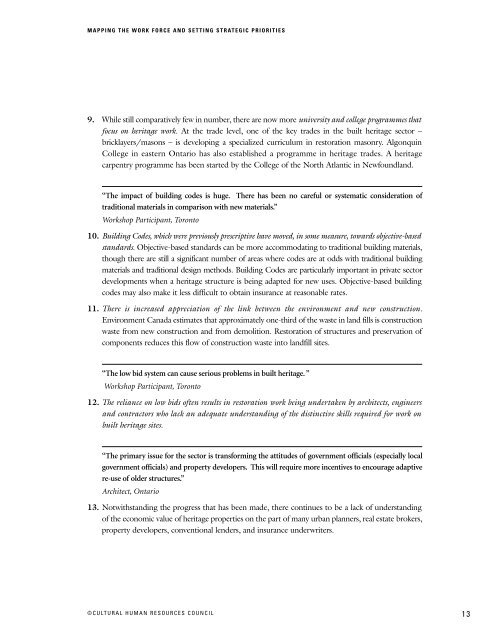Human Resources in Canada's Built Heritage Sector: Mapping the ...
Human Resources in Canada's Built Heritage Sector: Mapping the ...
Human Resources in Canada's Built Heritage Sector: Mapping the ...
- No tags were found...
You also want an ePaper? Increase the reach of your titles
YUMPU automatically turns print PDFs into web optimized ePapers that Google loves.
MAPPING THE WORK FORCE AND SETTING STRATEGIC PRIORITIES9. While still comparatively few <strong>in</strong> number, <strong>the</strong>re are now more university and college programmes thatfocus on heritage work. At <strong>the</strong> trade level, one of <strong>the</strong> key trades <strong>in</strong> <strong>the</strong> built heritage sector –bricklayers/masons – is develop<strong>in</strong>g a specialized curriculum <strong>in</strong> restoration masonry. Algonqu<strong>in</strong>College <strong>in</strong> eastern Ontario has also established a programme <strong>in</strong> heritage trades. A heritagecarpentry programme has been started by <strong>the</strong> College of <strong>the</strong> North Atlantic <strong>in</strong> Newfoundland.“The impact of build<strong>in</strong>g codes is huge. There has been no careful or systematic consideration oftraditional materials <strong>in</strong> comparison with new materials.”Workshop Participant, Toronto10. Build<strong>in</strong>g Codes, which were previously prescriptive have moved, <strong>in</strong> some measure, towards objective-basedstandards. Objective-based standards can be more accommodat<strong>in</strong>g to traditional build<strong>in</strong>g materials,though <strong>the</strong>re are still a significant number of areas where codes are at odds with traditional build<strong>in</strong>gmaterials and traditional design methods. Build<strong>in</strong>g Codes are particularly important <strong>in</strong> private sectordevelopments when a heritage structure is be<strong>in</strong>g adapted for new uses. Objective-based build<strong>in</strong>gcodes may also make it less difficult to obta<strong>in</strong> <strong>in</strong>surance at reasonable rates.11. There is <strong>in</strong>creased appreciation of <strong>the</strong> l<strong>in</strong>k between <strong>the</strong> environment and new construction.Environment Canada estimates that approximately one-third of <strong>the</strong> waste <strong>in</strong> land fills is constructionwaste from new construction and from demolition. Restoration of structures and preservation ofcomponents reduces this flow of construction waste <strong>in</strong>to landfill sites.“The low bid system can cause serious problems <strong>in</strong> built heritage. ”Workshop Participant, Toronto12. The reliance on low bids often results <strong>in</strong> restoration work be<strong>in</strong>g undertaken by architects, eng<strong>in</strong>eersand contractors who lack an adequate understand<strong>in</strong>g of <strong>the</strong> dist<strong>in</strong>ctive skills required for work onbuilt heritage sites.“The primary issue for <strong>the</strong> sector is transform<strong>in</strong>g <strong>the</strong> attitudes of government officials (especially localgovernment officials) and property developers. This will require more <strong>in</strong>centives to encourage adaptivere-use of older structures.”Architect, Ontario13. Notwithstand<strong>in</strong>g <strong>the</strong> progress that has been made, <strong>the</strong>re cont<strong>in</strong>ues to be a lack of understand<strong>in</strong>gof <strong>the</strong> economic value of heritage properties on <strong>the</strong> part of many urban planners, real estate brokers,property developers, conventional lenders, and <strong>in</strong>surance underwriters.©CULTURAL HUMAN RESOURCES COUNCIL13










